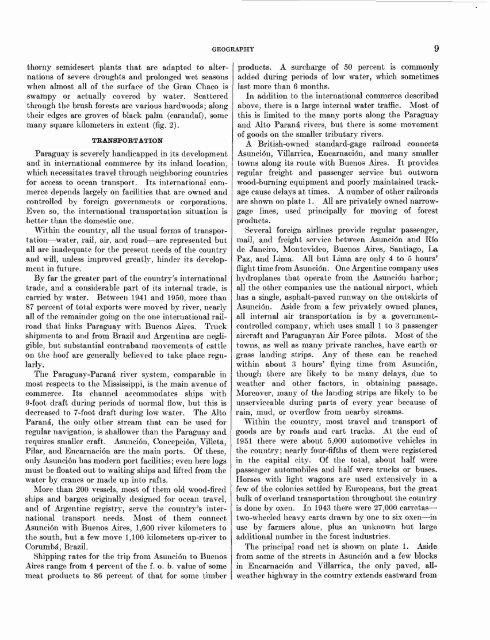Geology and Mineral Resources of Paraguay A Reconnaissance
Geology and Mineral Resources of Paraguay A Reconnaissance
Geology and Mineral Resources of Paraguay A Reconnaissance
- No tags were found...
You also want an ePaper? Increase the reach of your titles
YUMPU automatically turns print PDFs into web optimized ePapers that Google loves.
GEOGRAPHY 9thorny semidesert plants that are adapted to alternations<strong>of</strong> severe droughts <strong>and</strong> prolonged wet seasonswhen almost all <strong>of</strong> the surface <strong>of</strong> the Gran Chaco isswampy or actually covered by water. Scatteredthrough the brush forests are various hardwoods; alongtheir edges are groves <strong>of</strong> black palm (car<strong>and</strong>ai), somemany square kilometers in extent (fig. 2).TRANSPORTATION<strong>Paraguay</strong> is severely h<strong>and</strong>icapped in its development<strong>and</strong> in international commerce by its inl<strong>and</strong> location,which necessitates travel through neighboring countriesfor access to ocean transport. Its international commercedepends largely on facilities that are owned <strong>and</strong>controlled by foreign governments or corporations.Even so, the international transportation situation isbetter than the domestic one.Within the country, all the usual forms <strong>of</strong> transportationwater, rail, air, <strong>and</strong> road are represented butall are inadequate for the present needs <strong>of</strong> the country<strong>and</strong> will, unless improved greatly, hinder its developmentin future.By far the greater part <strong>of</strong> the country's internationaltrade, <strong>and</strong> a considerable part <strong>of</strong> its internal trade, iscarried by water. Between 1941 <strong>and</strong> 1950, more than87 percent <strong>of</strong> total exports were moved by river, nearlyall <strong>of</strong> the remainder going on the one international railroadthat links <strong>Paraguay</strong> with Buenos Aires. Truckshipments to <strong>and</strong> from Brazil <strong>and</strong> Argentina are negligible,but substantial contrab<strong>and</strong> movements <strong>of</strong> cattleon the ho<strong>of</strong> are generally believed to take place regularly.The <strong>Paraguay</strong>-Parana river system, comparable inmost respects to the Mississippi, is the main avenue <strong>of</strong>commerce. Its channel accommodates ships with9-foot draft during periods <strong>of</strong> normal flow, but this isdecreased to 7-foot draft during low water. The AltoParana, the only other stream that can be used forregular navigation, is shallower than the <strong>Paraguay</strong> <strong>and</strong>requires smaller craft. Asuncion, Conception, Villeta,Pilar, <strong>and</strong> Encarnacion are the main ports. Of these,only Asuncion has modern port facilities; even here logsmust be floated out to waiting ships <strong>and</strong> lifted from thewater by cranes or made up into rafts.More than 200 vessels, most <strong>of</strong> them old wood-firedships <strong>and</strong> barges originally designed for ocean travel,<strong>and</strong> <strong>of</strong> Argentine registry, serve the country's international transport needs. Most <strong>of</strong> them connectAsuncion with Buenos Aires, 1,600 river kilometers tothe south, but a few move 1,100 kilometers up-river toCorumba, Brazil.Shipping rates for the trip from Asuncion to BuenosAires range from 4 percent <strong>of</strong> the f. o. b. value <strong>of</strong> somemeat products to 86 percent <strong>of</strong> that for some timberproducts. A surcharge <strong>of</strong> 50 percent is commonlyadded during periods <strong>of</strong> low water, which sometimeslast more than 6 months.In addition to the international commerce describedabove, there is a large internal water traffic. Most <strong>of</strong>this is limited to the many ports along the <strong>Paraguay</strong><strong>and</strong> Alto Parana rivers, but there is some movement<strong>of</strong> goods on the smaller tributary rivers.A British-owned st<strong>and</strong>ard-gage railroad connectsAsuncion, Villarrica, Encarnacion, <strong>and</strong> many smallertowns along its route with Buenos Aires. It providesregular freight <strong>and</strong> passenger service but outwornwood-burning equipment <strong>and</strong> poorly maintained trackagecause delays at times. A number <strong>of</strong> other railroadsare shown on plate 1. All are privately owned narrowgagelines, used principally for moving <strong>of</strong> forestproducts.Several foreign airlines provide regular passenger,mail, <strong>and</strong> freight service between Asuncion <strong>and</strong> Riode Janeiro, Montevideo, Buenos Aires, Santiago, LaPaz, <strong>and</strong> Lima. All but Lima are only 4 to 5 hours'flight time from Asuncion. One Argentine company useshydroplanes that operate from the Asuncion harbor;all the other companies use the national airport, whichhas a single, asphalt-paved runway on the outskirts <strong>of</strong>Asuncion. Aside from, a few privately owned planes,all internal air transportation is by a governmentcontrolledcompany, which uses small 1 to 3 passengeraircraft <strong>and</strong> <strong>Paraguay</strong>an Air Force pilots. Most <strong>of</strong> thetowns, as well as many private ranches, have earth orgrass l<strong>and</strong>ing strips. Any <strong>of</strong> these can be reachedwithin about 3 hours' flying time from Asuncion,though there are likely to be many delays, due toweather <strong>and</strong> other factors, in obtaining passage.Moreover, many <strong>of</strong> the l<strong>and</strong>ing strips are likely to beunserviceable during parts <strong>of</strong> every year because <strong>of</strong>rain, mud, or overflow from nearby streams.Within the country, most travel <strong>and</strong> transport <strong>of</strong>goods are by roads <strong>and</strong> cart tracks. At the end <strong>of</strong>1951 there were about 5,000 automotive vehicles inthe country; nearly four-fifths <strong>of</strong> them were registeredin the capital city. Of the total, about half werepassenger automobiles <strong>and</strong> half were trucks or buses.Horses with light wagons are used extensively in afew <strong>of</strong> the colonies settled by Europeans, but the greatbulk <strong>of</strong> overl<strong>and</strong> transportation throughout the countryis done by oxen. In 1943 there were 27,000 carretastwo-wheeled heavy carts drawn by one to six oxen inuse by farmers alone, plus an unknown but largeadditional number in the forest industries.The principal road net is shown on plate 1. Asidefrom some <strong>of</strong> the streets in Asuncion <strong>and</strong> a few blocksin Encarnacion <strong>and</strong> Villarrica, the only paved, allweatherhighway in the country extends eastward from
















